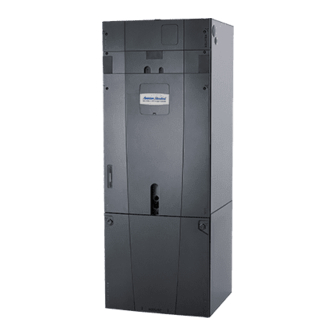
Table of Contents
Advertisement
Scan to see the
TAM7 Trouble-
shooting Video
Library.
ALL phases of this installation must comply with NATIONAL, STATE AND LOCAL CODES
Important: This Document is customer property and is to remain with this unit. Please return to service information
pack upon completion of work.
Important: These instructions do not cover all variations
in systems nor provide for every possible contingency
to be met in connection with the installation. Should
further information be desired or should particular
problems arise which are not covered sufficiently for the
purchaser's purposes, the matter should be referred to
your installing dealer or local distributor.
See the TAM7 Service Facts document for
information on reading the Control Board LEDs, Air
Flow Tables and Troubleshooting Flowcharts.
Note: The manufacturer recommends installing
ONLY A.H.R.I. approved, matched indoor and outdoor
systems. Some of the benefits of installing approved
matched indoor and outdoor split systems are maximum
efficiency, optimum performance, and the best overall
system reliability.
Note: Condensation may occur on the surface of the air
handler when installed in an unconditioned space. When
units are installed in unconditioned spaces, verify that
all electrical and refrigerant line penetrations on the air
handler are sealed completely.
The TAM7 air handlers will only use the following internal
electric heaters:
BAYEVAC05BK1AA
BAYEVAC05LG1AA
BAYEVAC08BK1AA
BAYEVAC08LG1AA
BAYEVAC10BK1AA
BAYEVAC10LG1AA
Note: Duct heaters cannot be applied
with this air handler.
Installer's Guide
Convertible Air Handlers
2 – 5 Ton
TAM7A0A24H21SB
TAM7A0B30H21SB
TAM7A0C36H31SB
TAM7A0C42H31SB
BAYEVBC15BK1AA
BAYEVBC20BK1AA
BAYEVCC25BK1AA
BAYEVAC10LG3AA
BAYEVBC15LG3AA
18-GJ06D2-1
TAM7A0C48H41SB
TAM7A0C60H51SB
TAM7B0C60H51SA
Advertisement
Table of Contents
















Need help?
Do you have a question about the TAM7A0A24H21SB and is the answer not in the manual?
Questions and answers
How to troubleshoot for codes
To troubleshoot error codes for the Trane TAM7A0A24H21SB:
1. Press and hold the Unit Test Button for 10–12 seconds.
2. Release the button and wait 5 seconds.
3. Cycle 230VAC power to the unit (removing the blower panel can help do this).
The system stores and reports the last four fault codes after each power cycle. Refer to the Fault Table in the Service Facts document for specific code meanings. If a fault occurs during Unit Test Mode, the LED will flash the code while continuing the test.
This answer is automatically generated